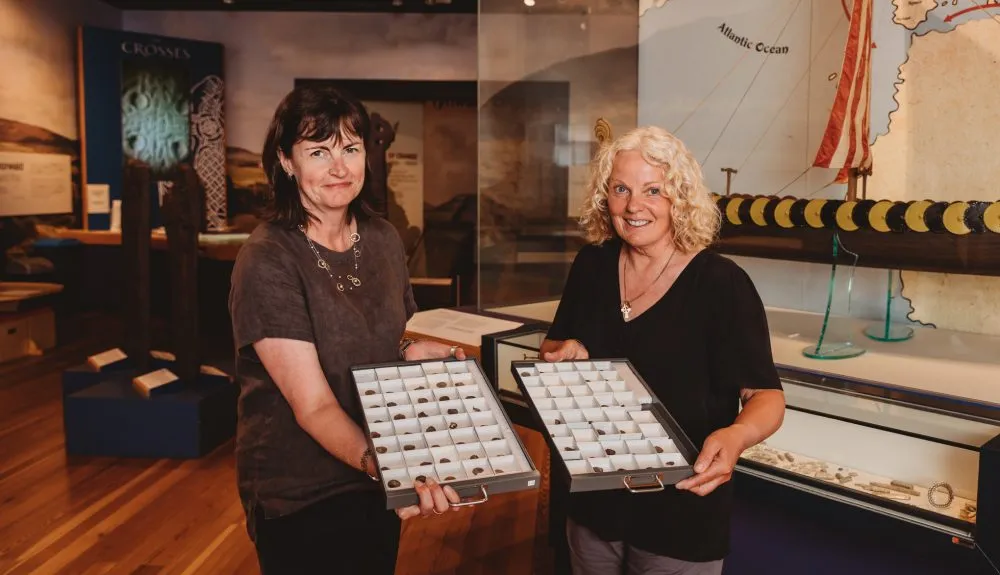Amateur Metal-Detectorist Finds Viking ‘Piggy Bank’ Filled With 1,000-Year-Old Silver Coins
Unearthed on the Isle of Man, experts suspect Vikings most likely added money to the stash over time
/https://tf-cmsv2-smithsonianmag-media.s3.amazonaws.com/filer/aa/c5/aac50422-8a9e-4e5b-804d-fd59d32abafa/217394183_10158163393302093_986397974222067467_n.jpeg)
In April, retired police officer and metal detecting enthusiast Kath Giles unearthed a Viking-era "piggy bank" filled with 1,000-year-old silver coins, jewelry and other artifacts on Isle of Man, a British dependency located off the northwest coast of England.
The find is Giles' fourth discovery since picking up metal-detecting as a hobby three years ago. She recently made news this February when she unearthed another trove of gold and silver Viking age jewelry.
BBC News reports her latest find contains some 87 silver coins, 13 pieces of metal arm-rings known as "hack silver” and several other artifacts. Experts suggest the pieces date between 1000 and 1035 A.D.
“The Northern Mixed hoard is the fourth Viking-Age coin hoard to be found in the Isle of Man in the last fifty years,” says Kristin Bornholdt Collins, an American coin expert who helped determine the provenance and age of the pieces, in a Manx National Heritage statement. “It may have been added to over time, like a piggybank, accounting for some of the older coins, though for the most part it is a direct reflection of what was circulating in and around Man in the late 1020s [to] 1030 A.D.”
According to Historic U.K., Vikings initially came to the Isle of Man between 800 and 815 A.D. The island later became an important trading post, connecting Dublin, northwest England and the Scottish Western Isles.
Experts suspect the treasure trove was intentionally hidden away for safekeeping. Vikings most likely added money to the so-called "piggy bank" over time, which would explain the presence of older coins in the collection, BBC News reports. Around 1035 A.D., a substantial deposit was added, so the stash mostly showed "a direct reflection of what was circulating in and around [the Isle of] Man in the late 1020s [and] 1030[s A.D.]," notes Bornholdt Collins in the statement.
The latest find features pennies minted on the Isle of Man, Ireland, England and Germany. The Irish and Manx coins depict King Sihtric Silkbeard, the Norse king of Dublin from 989 to 1036 A.D. The English and German coins feature King Aethelred II of England, a Holy Roman emperor named Otto of Saxony, and King Cnut of England, Denmark and Norway, reports Laura Geggel for Live Science.
The flip-side of several coins featured a "long cross" design, or a line etched into the currency that allowed patrons to cut it in two when only half a penny was needed. The new haul also has several silver objects similar to a stash of 464 Hiberno-Scandinavian coins called the Glenfaba deposit, which was discovered on the isle in 2003, Live Science reports.
Per the statement, the hack silver functioned as a kind of unregulated form of money comparable to modern cryptocurrency like Bitcoin. The hack silver was likely weighed to measure its value and used mainly for international transactions.

After Giles unearthed the objects, she informed Manx National Heritage, an organization responsible for protecting and conserving historical artifacts on the Isle of Man.
All archaeological discoveries made on the Isle of Man must be reported to Manx within two weeks, BBC News reports. If experts deem the artifacts treasure, Giles may receive a finder’s fee. (Current guidelines define treasure very narrowly, but as Caroline Davies reports for the Guardian, the United Kingdom government is working to expand these parameters to better protect the country’s national heritage items.)
Giles’ findings come amid an uptick in interest in metal detecting. Last year, the U.K. government recorded 47,000 archaeological discoveries in England and Wales, according to a statement released by the British Museum. Officials reported that Covid-19 restrictions led to an increase in finds, with many pandemic-worn Brits seeking respite outdoors. Treasures included gold coins inscribed with the initials of Henry VIII’s first three wives, rare Saxon pennies and a copper Roman furniture fitting.
The recently discovered hoard is now on exhibit in the new Viking gallery at the Manx Museum. Later, it will move to London, where the Treasure Valuation Committee will examine it at the British Museum.
/https://tf-cmsv2-smithsonianmag-media.s3.amazonaws.com/accounts/headshot/Isis_Davis-Marks_thumbnail.png)


/https://tf-cmsv2-smithsonianmag-media.s3.amazonaws.com/accounts/headshot/Isis_Davis-Marks_thumbnail.png)